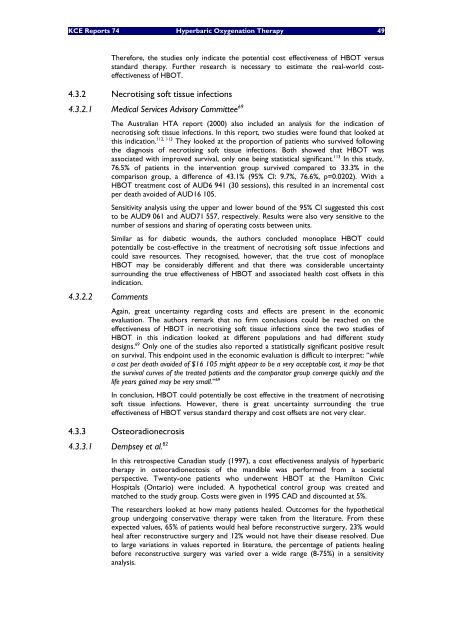Hyperbare Zuurstoftherapie: Rapid Assessment - KCE
Hyperbare Zuurstoftherapie: Rapid Assessment - KCE
Hyperbare Zuurstoftherapie: Rapid Assessment - KCE
You also want an ePaper? Increase the reach of your titles
YUMPU automatically turns print PDFs into web optimized ePapers that Google loves.
<strong>KCE</strong> Reports 74 Hyperbaric Oxygenation Therapy 49<br />
Therefore, the studies only indicate the potential cost effectiveness of HBOT versus<br />
standard therapy. Further research is necessary to estimate the real-world costeffectiveness<br />
of HBOT.<br />
4.3.2 Necrotising soft tissue infections<br />
4.3.2.1 Medical Services Advisory Committee 69<br />
The Australian HTA report (2000) also included an analysis for the indication of<br />
necrotising soft tissue infections. In this report, two studies were found that looked at<br />
this indication. 112, 113 They looked at the proportion of patients who survived following<br />
the diagnosis of necrotising soft tissue infections. Both showed that HBOT was<br />
associated with improved survival, only one being statistical significant. 113 In this study,<br />
76.5% of patients in the intervention group survived compared to 33.3% in the<br />
comparison group, a difference of 43.1% (95% CI: 9.7%, 76.6%, p=0.0202). With a<br />
HBOT treatment cost of AUD6 941 (30 sessions), this resulted in an incremental cost<br />
per death avoided of AUD16 105.<br />
Sensitivity analysis using the upper and lower bound of the 95% CI suggested this cost<br />
to be AUD9 061 and AUD71 557, respectively. Results were also very sensitive to the<br />
number of sessions and sharing of operating costs between units.<br />
Similar as for diabetic wounds, the authors concluded monoplace HBOT could<br />
potentially be cost-effective in the treatment of necrotising soft tissue infections and<br />
could save resources. They recognised, however, that the true cost of monoplace<br />
HBOT may be considerably different and that there was considerable uncertainty<br />
surrounding the true effectiveness of HBOT and associated health cost offsets in this<br />
indication.<br />
4.3.2.2 Comments<br />
Again, great uncertainty regarding costs and effects are present in the economic<br />
evaluation. The authors remark that no firm conclusions could be reached on the<br />
effectiveness of HBOT in necrotising soft tissue infections since the two studies of<br />
HBOT in this indication looked at different populations and had different study<br />
designs. 69 Only one of the studies also reported a statistically significant positive result<br />
on survival. This endpoint used in the economic evaluation is difficult to interpret: “while<br />
a cost per death avoided of $16 105 might appear to be a very acceptable cost, it may be that<br />
the survival curves of the treated patients and the comparator group converge quickly and the<br />
life years gained may be very small.” 69<br />
In conclusion, HBOT could potentially be cost effective in the treatment of necrotising<br />
soft tissue infections. However, there is great uncertainty surrounding the true<br />
effectiveness of HBOT versus standard therapy and cost offsets are not very clear.<br />
4.3.3 Osteoradionecrosis<br />
4.3.3.1 Dempsey et al. 82<br />
In this retrospective Canadian study (1997), a cost effectiveness analysis of hyperbaric<br />
therapy in osteoradionectosis of the mandible was performed from a societal<br />
perspective. Twenty-one patients who underwent HBOT at the Hamilton Civic<br />
Hospitals (Ontario) were included. A hypothetical control group was created and<br />
matched to the study group. Costs were given in 1995 CAD and discounted at 5%.<br />
The researchers looked at how many patients healed. Outcomes for the hypothetical<br />
group undergoing conservative therapy were taken from the literature. From these<br />
expected values, 65% of patients would heal before reconstructive surgery, 23% would<br />
heal after reconstructive surgery and 12% would not have their disease resolved. Due<br />
to large variations in values reported in literature, the percentage of patients healing<br />
before reconstructive surgery was varied over a wide range (8-75%) in a sensitivity<br />
analysis.

















